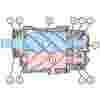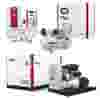Reach Out to Us
We are compressed air experts – you don’t need to be, once you have us!
For those who wish to get a better understanding of some essential terminology, we have prepared this short compressor glossary:
- Absolute Pressure - The existing gauge pressure plus atmospheric pressure measured from absolute zero.
- Aftercooler - Device that dissipates heat caused by compression after compression is complete. This allows for effective removal of moisture from the compressed air or gas.
- Air Receiver - Tank into which compressed air is delivered and stored. Proper tank size depends on mode of operation. Tank should be sized as recommended by manufacturer. Consult your local Gardner-Denver distributor for assistance.
- Atmospheric Pressure - Pressure at a specific altitude. At sea level, atmospheric pressure is 14.7 PSI.
- Brake Horsepower - The total power input required to compress and deliver a given quantity of air, including losses due to slip and friction as well as mechanical losses.
- Compression - The reduction of a specified volume within a specified cylinder, resulting in an increase in pressure.
- Compression Efficiency - Ratio of the theoretical to the actual work required to compress air. Takes into account slip leakage and frictional losses.
- Compression Ratio - The ratio of the Absolute Discharge Pressure to the Absolute Inlet Pressure.
- Compressor - A machine designed for compressing air or gas from an initial pressure to a higher discharge pressure.
- Design Pressure - Maximum continuous operating pressure as designed by the manufacturer. Also referred to as Maximum Working Pressure.
- Design Speed - Maximum continuous operating speed Design Speed - Maximum continuous operating speed of the compressor as designed by the manufacturer.
- Discharge Pressure - Total pressure at the discharge flange of the compressor.
- Discharge Temperature - The temperature at the discharge flange of the compressor.
- Free Air - Air at atmospheric conditions. Be careful with this term because altitude, barometric pressure and temperature will vary. This term may not mean air at identical conditions.
- Inlet Pressure - Total pressure at the inlet flange of the compressor or inlet filter.
- Inlet Temperature - Temperature at the inlet flange of the compressor or inlet filter.
- Load Factor - The ratio of the average actual compressor output to the maximum rated output of the compressor for a defined period of time.
- Moisture Separator - A device designed to collect and remove moisture from the air during the cooling process.
- Speed - Of a compressor is the number of revolutions per minute of the compressor shaft.
- Unloaded Horsepower - The power that is consumed to overcome the frictional losses when operating in an unloaded condition.
- Vacuum - Pressure below atmospheric. It is measured by a differential gauge which shows the difference between that pressure and atmospheric.
- Volumetric Efficiency - The ratio of the actual quantity of air delivered to the displacement of the compressor.
Related Information

ARTICLES
The latest articles published. Whether you are just learning, or are looking to brush up your existing knowledge.

GARDNER DENVER AIR COMPRESSORS
Gardner Denver portfolio of industrial air compressors include screw, reciprocating, vane and centrifugal air and gas compression.

DOWNLOADS CENTER
Air Compressors downloads and media library

